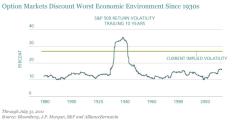This blog is part of a new series on Institutional Investor entitled Global Market Thought Leaders, a platform that provides analysis, commentary, and insight into the global markets and economy from the researchers and risk takers at premier financial institutions. our first contributor in this new section of Institutionalinvestor.com is AllianceBernstein, who will be providing analysis and insight into equities.
Investors’ recent actions suggest two somewhat contradictory fears. Some believe the world will end in the debasement of major currencies and hyperinflation (witness the price of gold). Others believe it will end in a great depression (witness Treasury bonds’ low yields, the Standard & Poor’s downgrade notwithstanding).
That’s not to say investor reactions to current conditions are entirely irrational. After all, investors worldwide are at the mercy of highly uncertain government policy. And you can still make a lot of money joining the multitudes in ‘crowded trades’ such as Treasury bonds, but you’d better exit before the outflows start.
One culprit in the 2008 financial crisis was the collective willingness to believe in a “great moderation.” This led investors to extrapolate a period of highly unusual stability in asset prices into the indefinite future — and hence dramatically increase their financial leverage.
On the other side of the crisis, investors are prone to equally extreme assumptions. This time they’re extrapolating that the intense volatility of 2008 will be with us forever. In fact, current long-dated options imply volatility over the next ten years that has actually occurred in only one period: the Great Depression (see display below).
The question is what the potential catalysts for the next reversal might be. Key elements would be providing economic stimulus and liquidity in the short term, as well as a credible long-term framework for addressing severe structural problems. More specifically, a solution might include:
• Congressional agreement on providing aid to U.S. small businesses
• Monetary easing in the emerging markets (increasingly a possibility as their economies cool off) and currency rerating
• A coherent framework for addressing the long-term debt and deficits in both Europe and the U.S.
• A global drop in commodity prices, which might do the seemingly impossible — boost consumer spending
• A repricing of U.S. risk assets as a result of a pickup in M&A activity or increased foreign direct investment by China or the oil-producing nations
None of the above is happening quite yet. But there are two positives that investors are overlooking in their dash to the exits:
• Higher consumer spending in the emerging countries — and not just for staple items — as their middle classes grow should have a ripple effect globally as the developing world buys and sells more goods.
• There is unequivocal evidence of underinvestment in capital equipment in the developed world. Businesses can stretch their plants and equipment only so far; the tipping point is on the near horizon.
So far, investors are having none of it, to the point that stock dividend yields are beginning to exceed bond yields.
If you don’t believe the world is ending — I do not — you’d want to own equities, particularly large-cap companies with superior relative growth and demonstrated pricing power, as well as those sitting on stockpiles of free cash. Many of those cash-rich companies are not yet returning cash to shareholders, but eventually the money will start flowing and their stocks will be rerated upward.
Arguing against the current focus on tail risk in light of our collective 2008 experience, the ongoing European debt crisis, slowing global economic growth and political gridlock in the U.S. may seem like starry-eyed optimism. But the response of asset prices to recent events, excessively influenced by 2008 and our desire to avoid making the same mistakes, is creating highly attractive investment opportunities.

The views expressed herein do not constitute research, investment advice or trade recommendations and do not necessarily represent the views of all AllianceBernstein portfolio management teams.
Vadim Zlotnikov is chief market strategist at AllianceBernstein.






